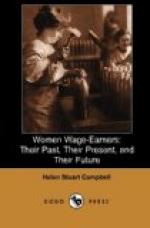In 1861 these returns gave for England and Wales 1,024,277 women at work. Twenty years later the number had doubled, half a million being found in London alone. This does not include all, since, as Mr. Charles Booth notes in his recent “Labor and Life of the People,” many employed women do not return their employments.
Mr. Booth’s work is a purely private enterprise, assisted by devoted co-workers, and by trained experts employed at his own expense. For the final estimate must be added general census returns, and the recent reports on the sweating-system in London and other English cities.
Beginning with factory operatives and their interests, nothing is easier than to follow the course of legislation on their behalf. The “Life of Lord Shaftesbury” is, in itself, the history of the movement for the protection of women and children,—a movement begun early in the present century, and made imperative by the hideous disclosures of oppression and outrage, not only among factory operatives, but the women and children in mining and other industries. Active as were his efforts and those of his colleagues, it is only within a generation that the fruit of their labor is plainly seen. As late as 1844, at the time Engel’s notable book on “The Condition of the Working-Class in England” appeared, the labor of children of four and five years was still permitted; and women and children alike worked in mines, in brickyards, and other exposed and dangerous employments for the merest pittance. The pages of Engel’s book swarm with incidents of individual and class misery; and while he admits fully, in the appendix prepared in 1886, that many of the evils enumerated have disappeared, he adds that for the mass of workers “the state of misery and insecurity in which they live now is as low as ever, perhaps lower.”
Year by year, in spite of constant agitation and the unceasing effort of Lord Shaftesbury to alter the worst abuses, these evils remained, and faced the examiner into social problems, slight ameliorations here and there serving chiefly to throw into darker relief the misery of the situation. Not only the philanthropist but officials joined hands; and in the proceedings of the British Association for the Advancement of Science, each year added to the number and importance of the protests against an iniquitous system.




